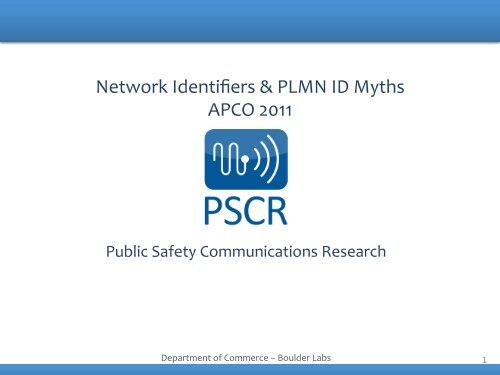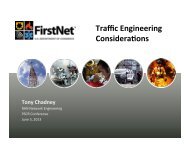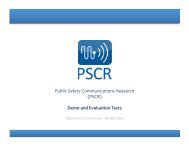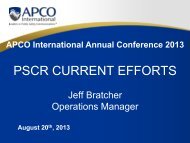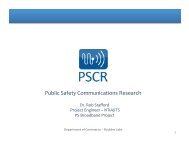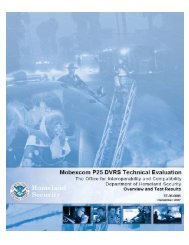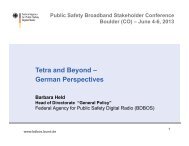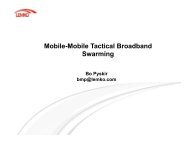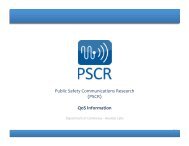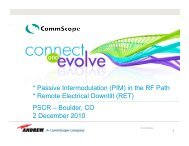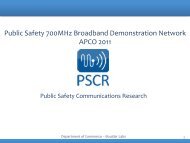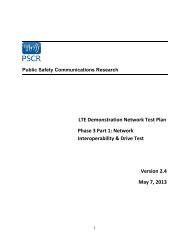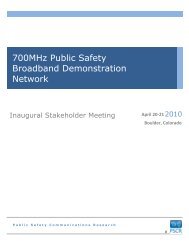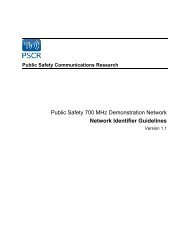Network Identifiers & PLMN ID Myths APCO 2011 - PSCR
Network Identifiers & PLMN ID Myths APCO 2011 - PSCR
Network Identifiers & PLMN ID Myths APCO 2011 - PSCR
Create successful ePaper yourself
Turn your PDF publications into a flip-book with our unique Google optimized e-Paper software.
<strong>Network</strong> <strong>Identifiers</strong> & <strong>PLMN</strong> <strong>ID</strong> <strong>Myths</strong> <br />
<strong>APCO</strong> <strong>2011</strong> <br />
Public Safety Communications Research <br />
Department of Commerce – Boulder Labs <br />
1
What is a <strong>PLMN</strong>? <br />
• <strong>PLMN</strong> – Public Land Mobile <strong>Network</strong> <br />
– <strong>PLMN</strong> = Home <strong>Network</strong> Identifier (HNI) ~ Public <br />
Mobile <strong>Network</strong> (PMN) <br />
– Consists of a Mobile Country Code and Mobile <br />
<strong>Network</strong> Code <br />
2
What is the <strong>PLMN</strong> used for? <br />
• The function of the MCC is to identify the <br />
domiciliary country of a mobile terminal/user. By <br />
analyzing the MCC, a visited network can <br />
determine the country from which the mobile <br />
terminal/user originated and in which its home <br />
network resides. <br />
• The function of the MNC is to identify the home <br />
network, within the country associated with the <br />
MCC, of the visiting mobile terminal/user. The <br />
visited network uses the MCC-‐MNC combination to <br />
identify and query the home network of the visiting <br />
mobile terminal/user that is requesting service. <br />
3
What is an IMSI? <br />
• Determination of the mobile terminal’s/user’s home <br />
network, <br />
• Mobile terminal/user identification when information about <br />
a specific mobile terminal/user is to be exchanged between <br />
visited and home networks, <br />
• Mobile station identification on the radio control path for <br />
registering a mobile station in a visited wireless network, <br />
• Mobile station identification for signaling on the radio <br />
control path, <br />
• Identification of the mobile terminal/user to allow for <br />
charging and billing of visiting mobile terminals/users, and <br />
• Subscription management, i.e., retrieving, providing, <br />
changing, and updating subscription data for a specific <br />
mobile terminal/user. *excerpt from IOC Guidelines <br />
4
Administration Stance <br />
• NTIA filed comments to the FCC Service Rules for <br />
the 698-‐746, 747-‐762 and 777-‐792 MHz Bands <br />
– Implementing a Nationwide,Broadband, Interoperable <br />
Public Safety <strong>Network</strong> in the 700 MHz Band <br />
– Amendment of Part 90 of the Commission’s Rules <br />
• Intra-‐public safety network roaming ceases to be a concern in a <br />
nationwide network, but remains a significant problem and <br />
cause of inefficiencies in a series of regional networks. The <br />
Corporation should require only a single Public Land Mobile <br />
<strong>Network</strong> (<strong>PLMN</strong>) identifier for the purpose of facilitating <br />
roaming among public safety users of a single nationwide public <br />
safety broadband network and commercial networks; <br />
5
Industry Support <br />
• ATIS WTSC send an industry support letter to <br />
the IOC for a single <strong>PLMN</strong> for public safety <br />
– Supported by multiple companies <br />
Alcatel-Lucent<br />
AT&T<br />
Aviat <strong>Network</strong>s<br />
CenturyLink<br />
Cisco Systems<br />
Clearwire<br />
Department of Commerce<br />
Department of Defense<br />
Ericsson<br />
FBI ESTS<br />
Huawei Technologies<br />
Intel<br />
InterDigital Communications<br />
Kineto Wireless, Inc.<br />
MetroPCS<br />
National Communications System<br />
Nokia Siemens <strong>Network</strong>s<br />
One2Many<br />
Public Safety Canada<br />
Qualcomm Inc.<br />
Research in Motion<br />
Rogers Wireless Inc.<br />
Sprint<br />
T-Mobile USA Inc.<br />
Telcordia Technologies<br />
TeleCommunications Systems, Inc.<br />
Tellabs Operations, Inc.<br />
TruePosition, Inc.<br />
Union Telephone Company<br />
Velleros<br />
Verizon Communications<br />
6
Key LTE <strong>Network</strong> <strong>Identifiers</strong><br />
IMSI - International Mobile Subscriber Identity<br />
MCC<br />
3 digits<br />
<strong>PLMN</strong> <strong>ID</strong><br />
MNC<br />
2-3 digits<br />
MSIN<br />
9-10 digits<br />
• <strong>PLMN</strong> <strong>ID</strong> - Public Land Mobile <strong>Network</strong> Identifier<br />
• MCC - Mobile Country Code<br />
• MNC - Mobile <strong>Network</strong> Code<br />
• MSIN - Mobile Subscriber Identification Number<br />
IMSI<br />
TAI - Tracking Area Identity<br />
MCC<br />
3 digits<br />
<strong>PLMN</strong> <strong>ID</strong><br />
MNC<br />
2-3 digits<br />
TAI<br />
TAC<br />
16 bits<br />
GUTI- Globally Unique Temporary UE Identity<br />
<strong>PLMN</strong> <strong>ID</strong><br />
MMEI<br />
• TAC - Tracking Area Code (per cell in eNodeB)<br />
• GUMMEI - Globally Unique MME Identifier<br />
• MMEI - MME Identifier<br />
• MMEGI - MME Group Identifier<br />
• MMEC - MME Code<br />
• S-TMSI - SAE Temporary Mobile Subscriber Identity<br />
• M-TMSI - MME Mobile Subscriber Identity<br />
S-TMSI<br />
MCC<br />
3 digits<br />
MNC<br />
2-3 digits<br />
MMEGI<br />
16 bits<br />
MMEC<br />
8 bits<br />
M-TMSI<br />
32 bits<br />
GUMMEI<br />
GUTI<br />
7
Key LTE <strong>Network</strong> <strong>Identifiers</strong><br />
ECGI - E-UTRAN Cell Global Identifier<br />
<strong>PLMN</strong> <strong>ID</strong><br />
ECI<br />
MCC<br />
3 digits<br />
MNC<br />
2-3 digits<br />
eNB <strong>ID</strong><br />
20 bits<br />
Cell <strong>ID</strong><br />
8 bits<br />
• ECI - E-UTRAN Cell Identifier<br />
Global eNB <strong>ID</strong><br />
ECGI<br />
IMEI- International Mobile station Equipment Identity<br />
Type Allocation Code<br />
8 digits<br />
Serial Number<br />
6 digits<br />
Spare<br />
1 digit<br />
IMEI<br />
IMEISV- IMEI and Software Version Number (SVN)<br />
Type Allocation Code<br />
8 digits<br />
Serial Number<br />
6 digits<br />
SVN<br />
2 digits<br />
IMEISV<br />
8
LTE <strong>Network</strong> Architecture & <strong>Identifiers</strong><br />
• IMSI<br />
• UE IP (static)<br />
• PGW <strong>ID</strong> (static)<br />
• PDN <strong>ID</strong> (APN)<br />
• IMSI<br />
• IMEI<br />
• eNB <strong>ID</strong><br />
• ECGI<br />
• MMEI<br />
• TAI<br />
• GUMMEI<br />
• TAI List rule<br />
eNB<br />
E-UTRAN Radio Access Bearer (E-RAB)<br />
Agency-A Apps<br />
APN(a)<br />
Internet<br />
APN(i)<br />
• PGW <strong>ID</strong><br />
• IP Pool (dynamic IP alloc)<br />
Agency-B Apps<br />
APN(b)<br />
LEGEND:<br />
eNB - evolved Node B<br />
MME - Mobility Mgmt Entity<br />
HSS - Home Subscriber Server<br />
DNS - Domain Name Server<br />
SGW - Serving Gateway<br />
PGW - Packet Data <strong>Network</strong><br />
Gateway<br />
PCRF - Policy & Charging Rules<br />
Function<br />
RED - Permanent (provisioned)<br />
9
Allocation <br />
10
Population Density <br />
11
Population Vs Land Area <br />
12
Study Item & Ad-‐Hoc <br />
• <strong>PSCR</strong> leading a Study Item Group <br />
– Register for portal access and group mail on <br />
www.pscr.gov <br />
• Meeting tdoay at the Marriott Downtown, <br />
1201 Market Street – Room 411 – Many <br />
Thanks to the <strong>APCO</strong> staff for providing this <br />
meeting facility for us. <br />
– We will start at 3pm ET/12 PT <br />
13
Emil Olbrich<br />
<br />
For Addi2onal Informa2on: <br />
h;p://www.pscr.gov <br />
QUESTIONS<br />
emil.olbrich@nist.gov <br />
& RESOURCE <br />
14


